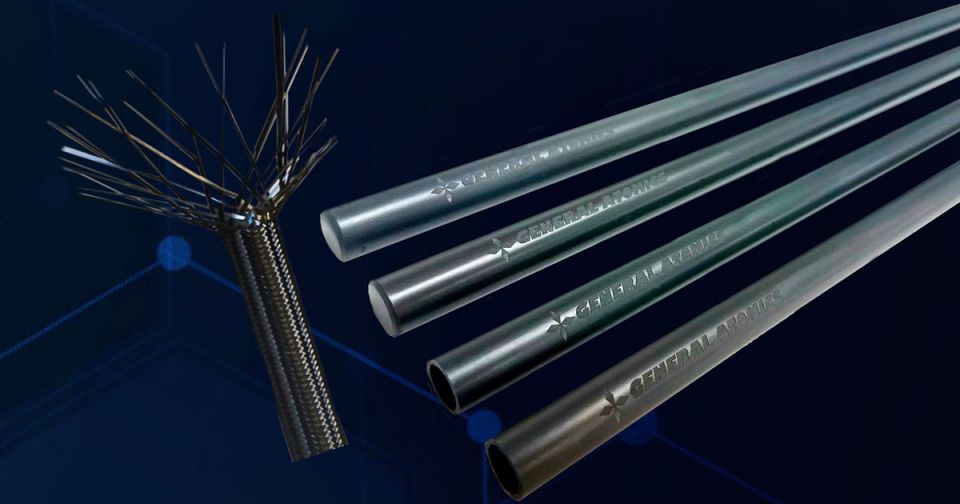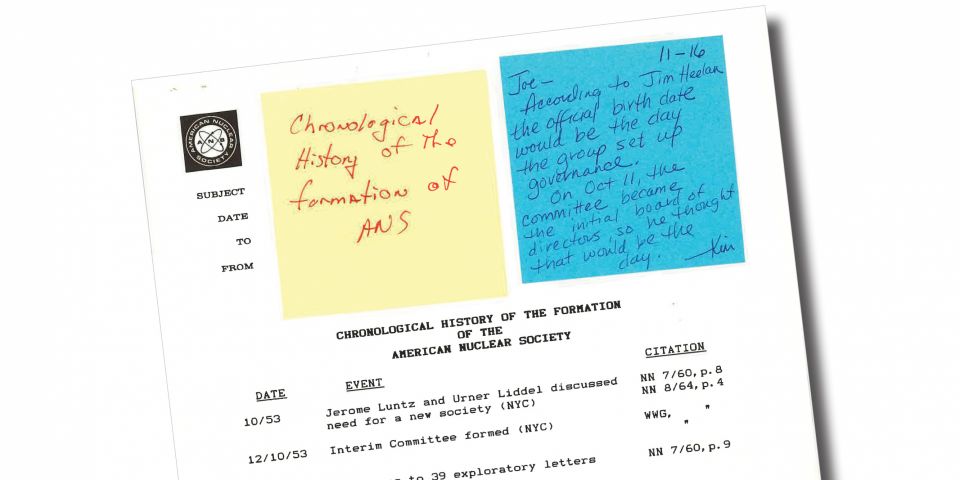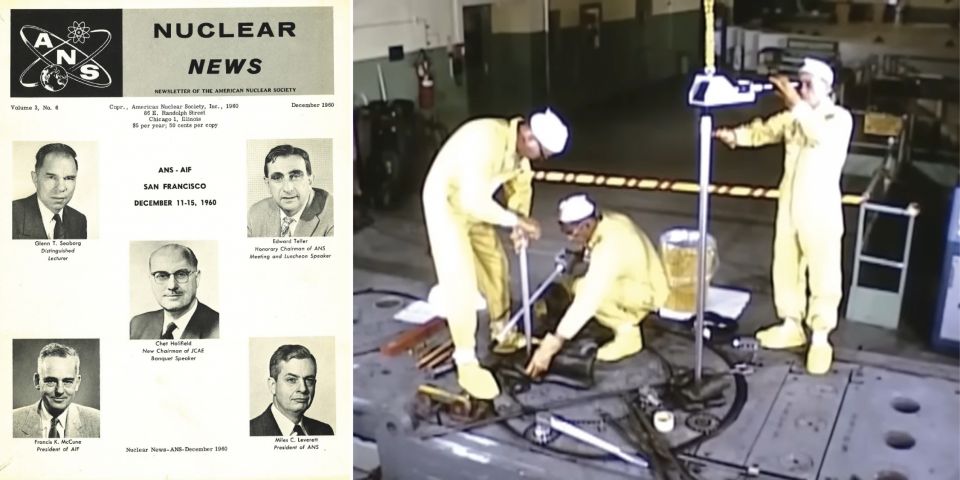Eisenhower's Atomic Power for Peace - The Civilian Application Program II

Westinghouse Electric Corporation promotional illustration showing "PWR" (Shippingport Atomic Power Station) plant and site. "Selected Articles on Nuclear Power," Westinghouse Electric (see sources).
The commercial nuclear power program in the United States was sparked by the Shippingport Atomic Power Station project-but one project does not a program make. Action by the U.S. Congress soon after the announcement of the project ensured that a wide program that would evaluate other approaches was launched:
"On July 31, 1953, the Joint Committee on Atomic Energy requested by letter that the Atomic Energy Commission prepare an outline of the objectives it seeks to achieve in the field of reactor development over the next five years and of its program for accomplishment of these goals." (1)
Thus, by letter, the first Five-Year Program to research and eventually construct commercial power reactors (as opposed to military, test, or research reactors) was begun. The Joint Committee on Atomic Energy (JCAE) wished to have the Atomic Energy Commission develop a fixed plan with clear objectives; the plan would also facilitate alignment of both federal and non-federal activities. As we will see shortly, very many reactor design concepts were considered before settling on several to push with federal funding. Response to the JCAE from the AEC was received in February 1954, and after review was published in unclassified report form by the JCAE in March 1954.
By the time this report was issued, there was already one clear leader in the development of power reactors-the still newly-announced PWR or pressurized water reactor. The project to construct this particular reactor, whose original conception was quite outside the scope of any coordinated AEC plan, was somewhat rapidly developed. The foreword to the AEC/1958 Geneva Conference volume entitled "Shippingport Pressurized Water Reactor," published in 1958, gives a retrospective look at the beginning of the PWR program:
"The decision to construct a large-scale pressurized water reactor plant came in 1953. For some years there had been a growing realization that planning for future nuclear power plants of two or three hundred megawatts electrical output could be made with greater confidence if operating experience from a reactor plant of intermediate power were available. At that time, the one large United States reactor project from which such experience might have been obtained had just been cancelled. This project (known as the CVR) was for the development of a large military pressurized water reactor for a naval ship. Consensus was reached among officials of the Atomic Energy Commission and members of the Joint Committee on Atomic Energy of the Congress that construction of a pressurized water central station plant, whose design would be extrapolated from the preliminary work carried out under the CVR project, would speed nuclear power development both in the United States and abroad.Formally authorized in July 1953, the civilian undertaking, often called the Pressurized Water Reactor project, got underway in its planning stages within weeks." (2)
As we can see, what appears to be a desire to preserve a continuous and uninterrupted development of light water cooled reactors (LWRs) by the AEC and JCAE due to the extreme and unexpected success of the LWR-based STR project (which produced the STR, later S1W, prototype and the highly successful and famous USS Nautilus' power plant) meant that the (temporarily) cancelled Navy aircraft carrier nuclear plant project was almost seamlessly transferred over to become the first commercial nuclear plant project-and this transfer happened at almost exactly the same time that the JCAE requested that the AEC develop a five-year R&D program for commercial reactors. The PWR was merged into the five-year plan along with its top competitors.
 This timeline of the first successful pressurized water reactor type nuclear plant (the STR prototype), as well as the USS Nautilus that used a copy of it, provides convenient comparison with the dates in this article and its predecessor. From "Selected Articles on Nuclear Power" - see 'sources.'
This timeline of the first successful pressurized water reactor type nuclear plant (the STR prototype), as well as the USS Nautilus that used a copy of it, provides convenient comparison with the dates in this article and its predecessor. From "Selected Articles on Nuclear Power" - see 'sources.'This timeline of the first successful pressurized water reactor type nuclear plant (the STR prototype), as well as the USS Nautilus that used a copy of it, provides convenient comparison with the dates in this article and its predecessor. From "Selected Articles on Nuclear Power" - see 'sources.'
Why both preserve the LWR concept development uninterrupted, and yet launch a competitive development program for other types of reactors? The answer is that it was not by any means yet certain which of the various reactor types built or considered was going to win out as the most viable economically and operationally. In 1953, multiple designs were being floated by numerous experts (and vendors); the PWR type was considered the most ready to build, but actually trailed the pack in estimates of long term economic viability.
Out of what the AEC described as "perhaps 80 or more" reactor concepts, five were selected for further development and graded as to their readiness for construction and as to their potential economic competitiveness.
The AEC stated that the PWR (formerly CVR, designed and built by Bettis Atomic Power Laboratory, Naval Reactors, and Westinghouse) and a sodium-cooled graphite moderated reactor (designed by North American Aviation) were the two designs ready for what it called "large experimental testing in the next 2 to 3 years." What it called "middle term" designs, ready for testing within five years, produced only the boiling water reactor concept of LWR, being designed by Argonne National Laboratory. Long term designs, not ready in less than five years, were a homogeneous reactor (fluid fuel solution, with the fuel suspended in water or some other appropriate fluid) proposed by Oak Ridge National Laboratories and a fast breeder reactor proposed by Argonne National Laboratory. (3)
- The projects listed in the Five-Year Plan were eventually built. Shown here is the HRE-2 experimental plant under construction at Oak Ridge National Laboratory; "core" is upper left. See next illustration. From "Atoms for Peace USA 1958" - see sources.
- HRE-2 reactor pressure vessel being installed. "Atoms for Peace USA 1958" - see sources.
1. Homogeneous reactor
2. Fast Breeder reactor
3. Boiling Water reactor
4. Sodium Graphite reactor
5. Pressurized Water reactor
The introductory material contained in the March 1954 JCAE report contains an exceedingly qualified description of the PWR project. Considering that particular design's eventual dominance of the nuclear energy field in many quarters, and contrasting that with the (now forgotten) rather dim view taken of this concept originally, reproduction of part of the description is interesting and follows:
"Pressurized water reactor - This is the only full-scale plant proposed by the Commission for construction at this time, although it is not as large as might be necessary to achieve maximum economy with this design. However, it is as large as is necessary to get operating experience and prove the design. Most witnesses and correspondents seem to feel that the other approaches will benefit from information and experience gained in the construction and operation of any large scale plant, including PWR. It is clearly of conservative design and has a poor long-term prospect for producing low-cost atomic power. On the other hand, it is the one approach now ready for full-scale construction as a demonstration of the generation of electricity from atomic energy. The achievement of economic atomic power by this approach will require the very greatest engineering skill, scientific ingenuity, and continuous research and study after the plant starts operating."
Included in the report are brief descriptions of the projects as envisioned. The Argonne concept for the boiling water reactor was said to be promising according to recent experiments, and would be proven by an eventual 20,000 kilowatt thermal experimental BWR which would drive a 5000-kilowatt turbine generator. The sodium graphite concept was under "extensive investigations" by North American, and would result in a 20,000-kw reactor with no turbogenerator. A fast breeder to follow EBR-I was announced under the plan, scaled up from the EBR-I rating of 1400 kilowatts to a core rating of 62,500 kilowatts. The (aqueous) homogeneous design would be built for this five-year program as an upscale of the HRE-I at Oak Ridge; the first reactor produced only 1000 kilowatts, but HRE-2 would produce 5000; this plant would include chemical reprocessing facilities and a turbogenerator. A further homogeneous thorium reactor was planned with a core rating of 65,000 kilowatts, and both electric generating and fuel reprocessing facilities. According to this report "considerable research and development will be necessary for both reactor projects."

The sodium-cooled project became the SRE or Sodium Reactor Experiment. "Lead shielded fueling cask over the loading face of the Sodium Reactor Experiment (SRE) at Santa Susana, California. Developed by Atomics International under contract to the AEC and built as a joint project, the SRE went critical in 1957 and is now supplying 6000 kw of power to the grid of the Southern California Edison Company." "Atoms for Peace USA 1958" - see sources.
Significant is a quote in the body of the report, in the section describing the concept of the program: "There is real confidence that atomic power can be produced at a cost competitive with fossil fuels such as coal and oil within the next decade by exploring these five approaches." This supported an AEC Statement of Policy on Nuclear Power Development (dated May 26, 1953), which stated in part that there was "a responsibility of the Commission to continue research and development in this (nuclear power) field and to promote the construction of experimental reactors that appear to contribute substantially to the power reactor art and constitute useful contributions to the design of economic units." That same policy letter also stated the "conviction of the Commission that progress toward economic nuclear power can be further advanced through participation in the development program by qualified and interested groups outside the Commission." What was being established then was that the federal government, through the AEC, was going to fund the initial development of power reactor prototypes under this five-year plan, but that "qualified and interested groups" clearly would include the civil sector. That inclusion was integral in Eisenhower's "Atomic Power for Peace" speech and approach to the JCAE and Congress. The development of the first five-year plan coupled with the Eisenhower mandate set the cornerstone for the U.S. nuclear industry.
Next time, we'll look at the provisions for and implementation of the Civilian Application Program, and see how this program was part of taking the AEC, the JCAE, and Eisenhower concepts and creating a conduit for learning first and innovation later.
----------
(1) "Atoms For Peace Manual," USGPO 1955, page 19.
(2) "Shippingport Pressurized Water Reactor." Westinghouse Electric/Naval Reactors/Duquesne Light, for AEC. Addison-Wesley, Reading Mass. 1958.
(3) Mentioned twice (once in the report, once in an appendix) were the plans to continue to pursue the Navy's metal-cooled reactor program and the rather wider but much less accomplished aircraft nuclear propulsion program that was spread among numerous entities. Neither of these programs would reach fully successful deployment after the expenditure of millions of dollars due to unforeseen technical problems.
----------
Sources for this article include:
ATOMS FOR PEACE MANUAL-A Compilation of Official Materials on International Cooperation for Peaceful Uses of Atomic Energy. 84th Congress, 1st Session, Document No. 55. July 1955 US Government Printing Office.
ATOMS FOR PEACE USA 1958-Hogerton, Ed. Prepared by Arthur D. Little Inc. for the US AEC, 1958.
SELECTED ARTICLES ON NUCLEAR POWER-Westinghouse Electric Corporation reprint 5240, collected from The Westinghouse Engineer.
______________________________
 Will Davis is a consultant to, and writer for, the American Nuclear Society; an active ANS member, he is serving on the ANS Communications Committee 2013-2016. In addition, he is a contributing author for Fuel Cycle Week, is secretary of the Board of Directors of PopAtomic Studios, and writes his own popular blog Atomic Power Review. Davis is a former US Navy reactor operator, qualified on S8G and S5W plants. He's also an avid typewriter collector in his spare time.
Will Davis is a consultant to, and writer for, the American Nuclear Society; an active ANS member, he is serving on the ANS Communications Committee 2013-2016. In addition, he is a contributing author for Fuel Cycle Week, is secretary of the Board of Directors of PopAtomic Studios, and writes his own popular blog Atomic Power Review. Davis is a former US Navy reactor operator, qualified on S8G and S5W plants. He's also an avid typewriter collector in his spare time.











